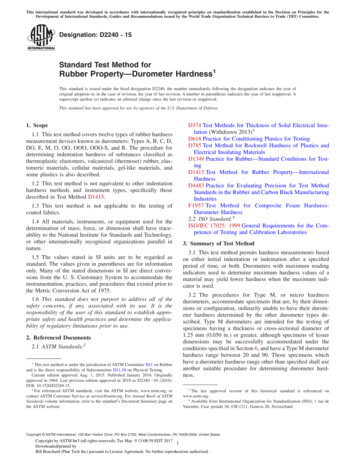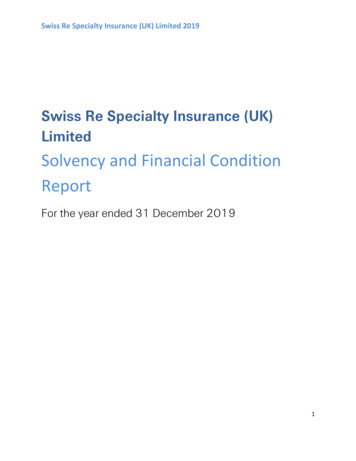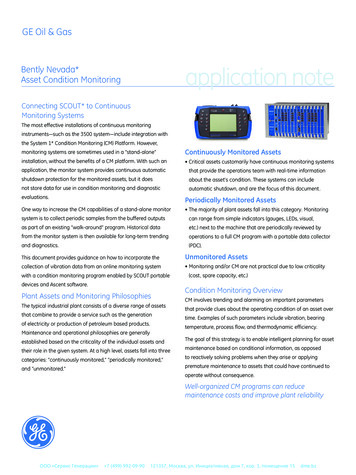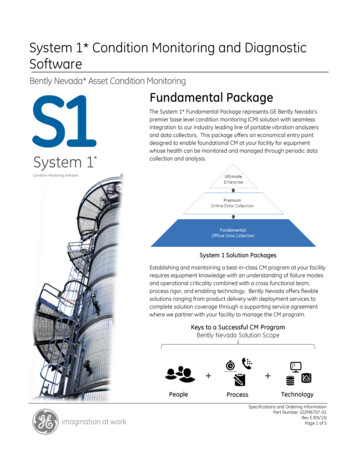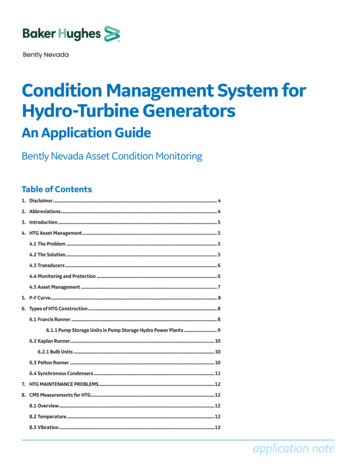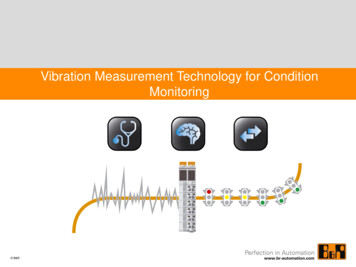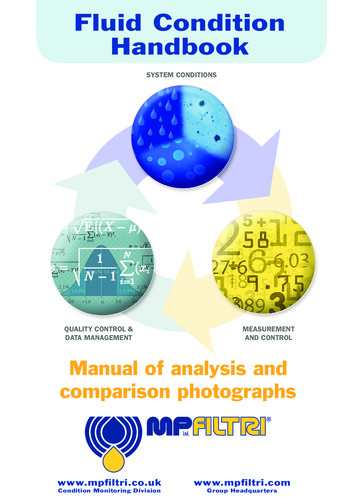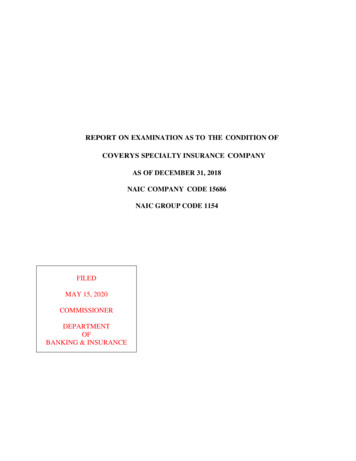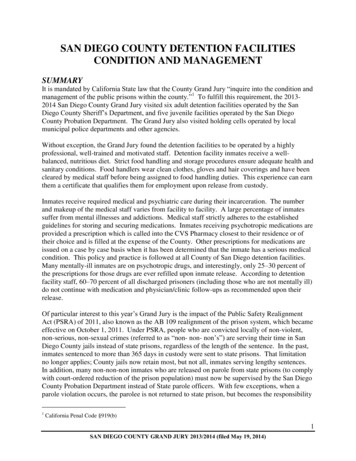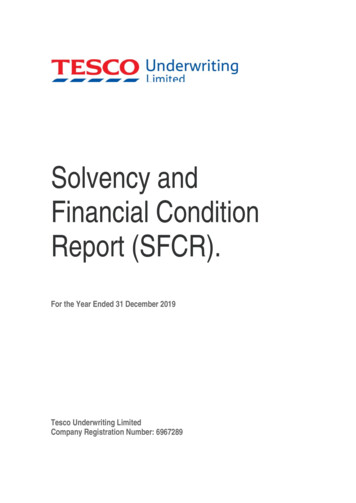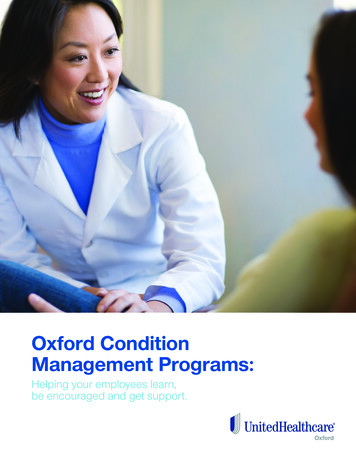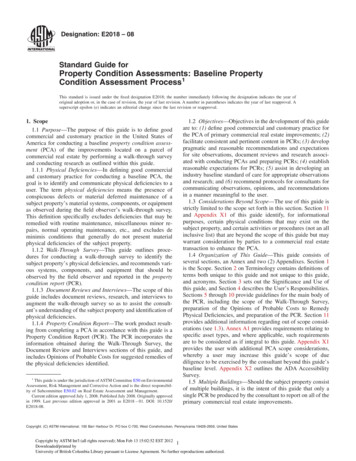
Transcription
Designation: E2018 – 08Standard Guide forProperty Condition Assessments: Baseline PropertyCondition Assessment Process1This standard is issued under the fixed designation E2018; the number immediately following the designation indicates the year oforiginal adoption or, in the case of revision, the year of last revision. A number in parentheses indicates the year of last reapproval. Asuperscript epsilon ( ) indicates an editorial change since the last revision or reapproval.1. Scope1.1 Purpose—The purpose of this guide is to define goodcommercial and customary practice in the United States ofAmerica for conducting a baseline property condition assessment (PCA) of the improvements located on a parcel ofcommercial real estate by performing a walk-through surveyand conducting research as outlined within this guide.1.1.1 Physical Deficiencies—In defining good commercialand customary practice for conducting a baseline PCA, thegoal is to identify and communicate physical deficiencies to auser. The term physical deficiencies means the presence ofconspicuous defects or material deferred maintenance of asubject property’s material systems, components, or equipmentas observed during the field observer’s walk-through survey.This definition specifically excludes deficiencies that may beremedied with routine maintenance, miscellaneous minor repairs, normal operating maintenance, etc., and excludes deminimis conditions that generally do not present materialphysical deficiencies of the subject property.1.1.2 Walk-Through Survey—This guide outlines procedures for conducting a walk-through survey to identify thesubject property’s physical deficiencies, and recommends various systems, components, and equipment that should beobserved by the field observer and reported in the propertycondition report (PCR).1.1.3 Document Reviews and Interviews—The scope of thisguide includes document reviews, research, and interviews toaugment the walk-through survey so as to assist the consultant’s understanding of the subject property and identification ofphysical deficiencies.1.1.4 Property Condition Report—The work product resulting from completing a PCA in accordance with this guide is aProperty Condition Report (PCR). The PCR incorporates theinformation obtained during the Walk-Through Survey, theDocument Review and Interviews sections of this guide, andincludes Opinions of Probable Costs for suggested remedies ofthe physical deficiencies identified.1This guide is under the jurisdiction of ASTM Committee E50 on EnvironmentalAssessment, Risk Management and Corrective Action and is the direct responsibility of Subcommittee E50.02 on Real Estate Assessment and Management.Current edition approved July 1, 2008. Published July 2008. Originally approvedin 1999. Last previous edition approved in 2001 as E2018 – 01. DOI: 10.1520/E2018-08.1.2 Objectives—Objectives in the development of this guideare to: (1) define good commercial and customary practice forthe PCA of primary commercial real estate improvements; (2)facilitate consistent and pertinent content in PCRs; (3) developpragmatic and reasonable recommendations and expectationsfor site observations, document reviews and research associated with conducting PCAs and preparing PCRs; (4) establishreasonable expectations for PCRs; (5) assist in developing anindustry baseline standard of care for appropriate observationsand research; and (6) recommend protocols for consultants forcommunicating observations, opinions, and recommendationsin a manner meaningful to the user.1.3 Considerations Beyond Scope—The use of this guide isstrictly limited to the scope set forth in this section. Section 11and Appendix X1 of this guide identify, for informationalpurposes, certain physical conditions that may exist on thesubject property, and certain activities or procedures (not an allinclusive list) that are beyond the scope of this guide but maywarrant consideration by parties to a commercial real estatetransaction to enhance the PCA.1.4 Organization of This Guide—This guide consists ofseveral sections, an Annex and two (2) Appendixes. Section 1is the Scope. Section 2 on Terminology contains definitions ofterms both unique to this guide and not unique to this guide,and acronyms. Section 3 sets out the Significance and Use ofthis guide, and Section 4 describes the User’s Responsibilities.Sections 5 through 10 provide guidelines for the main body ofthe PCR, including the scope of the Walk-Through Survey,preparation of the Opinions of Probable Costs to RemedyPhysical Deficiencies, and preparation of the PCR. Section 11provides additional information regarding out of scope considerations (see 1.3). Annex A1 provides requirements relating tospecific asset types, and where applicable, such requirementsare to be considered as if integral to this guide. Appendix X1provides the user with additional PCA scope considerations,whereby a user may increase this guide’s scope of duediligence to be exercised by the consultant beyond this guide’sbaseline level. Appendix X2 outlines the ADA AccessibilitySurvey.1.5 Multiple Buildings—Should the subject property consistof multiple buildings, it is the intent of this guide that only asingle PCR be produced by the consultant to report on all of theprimary commercial real estate improvements.Copyright. (C) ASTM International. 100 Barr Harbour Dr. PO box C-700, West Conshohocken, Pennsylvania 19428-2959, United StatesCopyright by ASTM Int'l (all rights reserved); Mon Feb 13 15:02:52 EST 20121Downloaded/printed byUniversity of British Columbia Library pursuant to License Agreement. No further reproductions authorized.
E2018 – 081.6 Safety Concerns—This guide does not purport to address all of the safety concerns, if any, associated with thewalk-through survey. It is the responsibility of the consultantusing this guide to establish appropriate safety and healthpractices when conducting a PCA.1234567TABLE OF ons Beyond Scope1.4Organization of This Guide1.5Multiple Buildings1.6Safety ConcernsTerminology2.2Definitions2.3Definitions of Terms Specific to This Standard2.4Abbreviations and AcronymsSignificance and Use3.1Use3.2Clarification of Use3.3Who May Conduct3.4Principles3.5Prior PCR Usage3.6Rules of EngagementUser’s Responsibilities4.1Access4.2User DisclosureProperty Condition Assessment5.1Objective5.2PCA Components5.3Coordination of Components5.4Consultant’s DutiesThe Consultant6.1Qualifications of the Consultant6.2Staffing of the Field Observer6.3Independence of the Consultant6.4Qualifications of the Field Observer6.5Qualifications of the PCR Reviewer6.6The Field Observer and PCR Reviewer May Be a Single Individual6.7Not a Professional Architecture or Engineering ServiceDocument Review and Interviews7.1Objective7.2Reliance7.3Accuracy and Completeness7.4Government Agency Provided Information7.5Pre-Survey Questionnaire7.6Owner/User Provided Documentation and Information7.7Interviews8Walk-Through pe8.5Additional Considerations9Opinions of Probable Costs to Remedy Physical Deficiencies9.1Purpose9.2Scope9.3Opinions of Probable Costs Attributes10Property Condition Report10.1 Format10.2 Writing Protocols10.3 Documentation10.4 Credentials10.5 Executive Summary10.6 Purpose and Scope10.7 Walk-Through Survey10.8 Document Reviews and Interviews10.9 Additional Considerations10.10 Opinions of Probable Costs10.11 Qualifications10.12 Limiting Conditions10.13 Exhibits11Out of Scope Considerations11.1 Activity Exclusions11.2 Warranty, Guarantee, and Code Compliance Exclusions11.3 Additional/General ConsiderationsAnnex A1A1.1 Multifamily PropertiesA1.2 Commercial Office BuildingsA1.3 Retail BuildingsAppendix X1X1.1 QualificationsX1.2 Verification of Measurements and QuantitiesX1.3 ResearchX1.4 Flood Plain DesignationX1.5 Recommended Table of ContentsAppendix X2X2.1 Overview of The Americans with Disabilities ActX2.2 Overview of the Americans with Disabilities Act Accessibility Guidelines (ADAAG)X2.3 Variable Levels of Due DiligenceX2.4 Definitions of Terms Specific to Understanding the Americans withDisabilities ActX2.5 Presentation of Opinions of Probable CostsX2.6 Tier I: Visual Accessibility SurveyX2.7 Tier II: Abbreviated Accessibility SurveyX2.8 Tier III: Full Accessibility SurveyCopyright by ASTM Int'l (all rights reserved); Mon Feb 13 15:02:52 EST 20122Downloaded/printed byUniversity of British Columbia Library pursuant to License Agreement. No further reproductions authorized.
E2018 – 082. Terminology2.1 This section provides definitions, descriptions of terms,and a list of acronyms, where applicable, for the words used inthis guide. The terms are an integral part of the guide and arecritical to an understanding of this guide and its use.2.2 Definitions:2.2.1 architect, n—designation reserved by law for a personprofessionally qualified, examined, and registered by the appropriate governmental board having jurisdiction, to performarchitectural services including, but not limited to, analysis ofproject requirements and conditions, development of projectdesign, production of construction drawings and specifications,and administration of construction contracts.2.2.2 building codes, n—rules and regulations adopted bythe governmental authority having jurisdiction over the commercial real estate, which govern the design, construction,alteration, and repair of such commercial real estate. In somejurisdictions, trade or industry standards may have beenincorporated into, and made a part of, such building codes bythe governmental authority. Building codes are interpreted toinclude structural, HVAC, plumbing, electrical, life-safety, fire,health, and vertical transportation codes.2.2.3 building department records, n—records maintainedby or in possession of the local government authority withjurisdiction over the construction, alteration, use, or demolitionof improvements on the subject property, and that are readilyavailable for use by the consultant within the time framerequired for production of the PCR and are practically reviewable by exercising appropriate inquiry. Building departmentrecords also may include building code violation notices.Often, building department records are located in the buildingdepartment of a municipality or county, or available online.2.2.4 building systems, n—interacting or independent components or assemblies, which form single integrated units thatcomprise a building and its site work, such as, pavement andflatwork, structural frame, roofing, exterior walls, plumbing,HVAC, electrical, etc.2.2.5 component, n—a fully functional portion of a buildingsystem, piece of equipment, or building element.2.2.6 dismantling, n—to take apart, move, or remove anycomponent, device, or piece of equipment that is bolted,screwed, held in-place (mechanically or by gravity), secured,or fastened by other means.2.2.7 engineer, n—designation reserved by law for a personprofessionally qualified, examined, and licensed by the appropriate governmental board having jurisdiction, to performengineering services.2.2.8 engineering, n—analysis or design work requiringextensive formal education, preparation, and experience in theuse of mathematics, chemistry, physics, and the engineeringsciences.2.2.9 fire department records, n—records maintained by orin the possession of the local fire department in the area inwhich the subject property is located. These records should bepractically reviewable and readily accessible for use by theconsultant by exercising an appropriate inquiry within the timeframe required for production of the PCR.2.2.10 guide, n—a series of options and instructions that donot recommend a specific course of action.2.2.11 interviews, n—discussions with those knowledgeableabout the subject property.2.2.12 material, adj—having significant importance or greatconsequence to the subject property’s intended use or physicalcondition.2.2.13 practice, n—a definitive procedure for performingone or more specific operations or functions that does notproduce a test result.2.2.14 publicly available, adj—the source of the information allows access to the information by anyone upon request.2.2.15 recreational facilities, n—facilities for exercise, entertainment or athletics including, without limitation, swimming pools, spas, saunas, steam baths, tennis, volleyball, orbasketball courts; jogging, walking, or bicycle paths; andplayground equipment.2.2.16 structural frame, n—the components or buildingsystem that supports the building’s nonvariable forces orweights (dead loads) and variable forces or weights (liveloads).2.2.17 standard, n—as used by ASTM, a document that hasbeen developed and established within the consensus principlesof the Society and that meets the approval of the ASTMprocedures and regulations.2.2.18 system, n—a combination of interacting or interdependent components assembled to carry out one or morefunctions.2.3 Definitions of Terms Specific to This Standard:2.3.1 actual knowledge, n—the knowledge possessed by anindividual rather than an entity. Actual knowledge, as used inthis guide, is to be distinguished from knowledge provided byothers, or information contained on documents obtained duringthe course of conducting a PCA.2.3.2 appropriate inquiry, n—a request for informationconducted by Freedom of Information Letter (FOIL), verbalrequest, or by other written request made either by fax,electronic mail, overnight courier, or U.S. mail. Appropriateinquiry includes a good-faith effort conducted by the consultantto obtain the information considering the time constraints toprepare and deliver the PCR.2.3.3 base building, n—the core (common areas) and shellof the building and its systems that typically are not subject toimprovements to suit tenant requirements.2.3.4 baseline, n—the minimum level of observations, duediligence, inquiry/research, documentation review, and preparation of opinions of probable costs t
(C) ASTM International. 100 Barr Harbour Dr. PO box C-700, West Conshohocken, Pennsylvania 19428-2959, United States Copyright by ASTM Int'l (all rights reserved); Mon Feb 13 15:02:52 EST 2012 Downloaded/printed byFile Size: 670KBPage Count: 25
